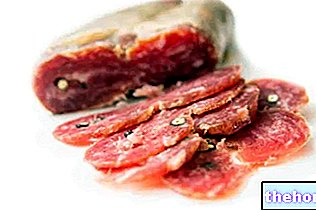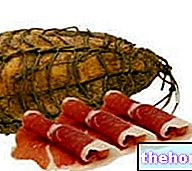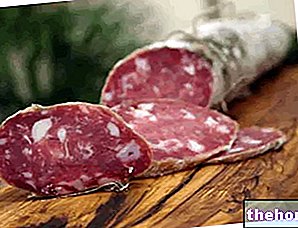What is Speck
Speck is a smoked cured meat that can be classified in the group of "salted meats". It is a typical South Tyrolean product, created by the local populations around the 13th century AD to preserve meat in the absence of more advanced equipment.
The starting raw material is the pork leg (binomial nomenclature: Sus scrofa domesticus), or the same as the ham; however, speck is distinguished from the latter by a different and characteristic manufacturing process, which gives it unique organoleptic characteristics of its kind.

Nutritional Properties
From a nutritional point of view, speck is a very energetic food, whose calories come exclusively from proteins (with a high biological value) and from lipids.The fatty acids contained in its triglycerides are mainly of the unsaturated type, therefore they should not excessively harm the lipid metabolism. However, the absolute quantity of saturated fatty acids is quite high (1/4 of the total, equal to 5g / 100g of product) and this aspect, emphasized by the presence of cholesterol, assumes a certain health importance (especially in the diet of hypercholesterolemic subjects ).
Carbohydrates (except for traces of sucrose in the external portion), as well as fibers, are absent; on the contrary, cholesterol seems significant.
As far as the saline profile is concerned, there is a notable sodium intake. The nutritional excess of this macro-element is involved in the onset and / or aggravation of arterial hypertension, which is why it is necessary that speck, other salty foods and discretionary salt are correctly contextualized to ensure the overall balance . There is also an "excellent portion of bioavailable iron, a microelement particularly useful for fertile women, especially during pregnancy (a period during which the consumption of fresh or slightly seasoned cured meats, such as sausage, or artisanal production, is contraindicated); speck on the other hand, it is considered relatively safe even for pregnant women at risk of toxoplasmosis.) The potassium content is also significant.
With regard to vitamins, the contributions of water-soluble molecules of group B (thiamin, niacin, cobalamin, etc.) are appreciable.

Nutritional values (per 100 g of edible portion)
Remember that speck is a food subjected to smoking, which certainly does not represent a healthy method of preservation. Without triggering unnecessary alarmism, it must be specified that the high consumption of smoked foods is considered one of the many risk factors for the onset of stomach cancer.
Furthermore, since it is a preserved meat, commercial speck contains a fair amount of nitrites and nitrates. These are molecules that are important for maintaining food healthiness (they prevent the development of botulinum) but which, if taken in excess, are also involved in the onset of stomach cancer.
It should also be specified that the association, in the same meal, of speck with a dish rich in fresh vegetables, therefore in antioxidant molecules and dietary fiber, is able to mitigate the harmful effects of these potentially carcinogenic substances. of an "approximate indication that has no" proportional "reliability.
The IGP mark - in the specific case of South Tyrolean speck "Südtirol" and in general for all other certified products - guarantees not only superior organoleptic characteristics, but also greater protection for the health of the consumer (for example, a reduced use of preservatives or flavor enhancers, widely used by the food industry to disguise the poor quality of the raw material).
Like all preserved meats, speck should also be consumed with the right moderation, therefore in smaller portions (compared to fresh meat) and with a maximum frequency of once or twice a week. The massive presence of table salt and the significant presence of cholesterol and saturated fats make it a product completely unsuitable for the diet of those suffering from metabolic diseases (in particular, hypercholesterolemia and arterial hypertension), of those who are simply predisposed and of those who has a higher than normal cardio-vascular risk.
If used as a dish, the average portion of speck (preferably without visible fat) must be between 50 and 100g of product.
Gastronomic Aspects
Speck can be used as a dish (sliced, similar to other cured meats), or as an ingredient in appetizers, first courses, single dishes, pizza, special bread, etc .; in this case, speck proves to be an excellent substitute (certainly no less valuable) than the traditional diced bacon, much richer in fat, cholesterol and calories.
ATTENTION! Speck-based recipes can include it raw or cooked; in the latter case I strongly suggest AVOIDING the additional addition of table salt.
Some famous speck-based recipes are: Tyrolean vol au vent, spatzle with cream and speck, various quiches with speck, radicchio risotto wrapped in speck, etc.




























